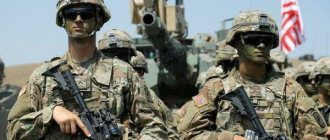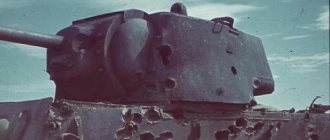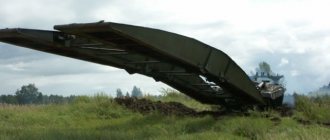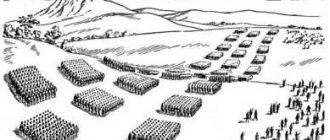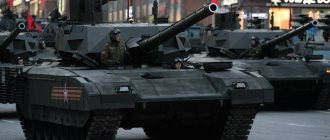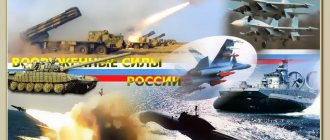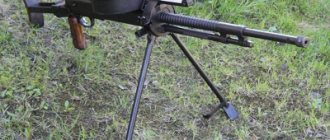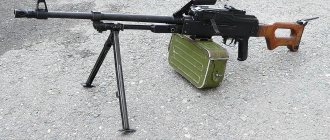According to the spheres of influence and activity, the Russian Armed Forces are divided into three types: the Navy (Navy), the Aerospace Forces (Aerospace Forces) and the Ground Forces. Each branch includes several branches of the military - military formations, united by a certain structure, technical support unique to them, characteristic weapons and an emblem.
A tank division is the main structural and tactical combat unit of tank forces that are part of the Ground Forces, along with motorized rifle troops, special forces, RVIA (missile forces and artillery), infantry and others.
Brief historical background
Armored forces begin their historical countdown with imperial Russia at the beginning of the 20th century, when foreign tanks were adopted. Serial production of domestic cars began in the 20s. The first tank divisions of the Soviet Army were formed in 1940.
With the beginning of the Great Patriotic War, the divisional organization of troops was replaced by a brigade organization. The main units were tank battalions and brigades. In June 1945, tank brigades were reorganized into regiments, and corps into divisions.
During the military reform of 2008–2009. The divisional structure was again replaced by a brigade structure. The reconstruction of tank divisions began in 2016. The first were the famous tank formations near Moscow - the Kantemirovskaya and Tamanskaya divisions.
General tactics
MINISTRY OF DEFENSE OF THE RUSSIAN FEDERATIONMILITARY ENGINEERING ACADEMYFAR EASTERN HIGHER MILITARY COMMAND SCHOOLGENERAL TACTICSIN THE TRAINING COURSE OF HIGHER MILITARY EDUCATIONAL INSTITUTIONS OF THE GROUND FORCESTutorialEdition – 2005annotation
The textbook is intended to assist cadets of higher military educational institutions of the Russian Ground Forces in preparing for practical classes (group classes) in the discipline “General Tactics”.
The manual was developed on an initiative basis by a team of authors from the Military Engineering Academy and the Far Eastern Higher Military Command School:
team from the Military Engineering Academy - S.A. Batyushkin, V.N. Aleksandrov, A.Yu. Zhidkov, M.G. Myachin, V.G. Nikiforov, A.V. Grekov, K.V. Katyshev, V. A. Isachenko, V. V. Goncharuk, E. N. Tomilko, V.V. Kupriyanov;
team from the Far Eastern Higher Military Command School - ………
………
The manual was developed under the general editorship of the head of the department of operational-tactical training of the Military Engineering Academy, Doctor of Military Sciences, professor, laureate of the Prize named after. A.A. Svechin, full member of the Academy of Military Sciences and the Academy of Defense, Security and Law Enforcement, Colonel S.A. Batyushkina.
Table of contents
| Page | |
| annotation | 1 |
| Introduction | 3 |
| Chapter first. Introduction to military specialty | 4 |
| Chapter two. Armed Forces of the Russian Federation | 12 |
| Chapter three. Basic Tactics | 24 |
| Chapter Four. Tactics of units and units of foreign armies | 36 |
| Chapter five. Department management | 49 |
| Chapter six. Motorized rifle (tank) units in defense | 59 |
| Chapter seven. Motorized rifle (tank) units on the offensive | 80 |
| Chapter eight. Movement of motorized rifle (tank) units | 101 |
| Chapter Nine. Features of combat operations during an armed conflict | 117 |
| Conclusion | 131 |
| Applications | 133 |
Introduction
Tactics is an integral part of the art of war, covering the theory and practice of preparing and conducting combat by subunits, units and formations of various branches of the Armed Forces, branches of troops (forces) and special troops. Like other parts of the art of war, tactics are in constant development. The determining influence on the state and development of tactics is exerted by weapons and military equipment, the level of training of troops, and the art of leading them.
The changes that have occurred in the organizational structure of units and subunits, the improvement of weapons and military equipment have entailed changes in the nature of combined arms combat and methods of conducting combat operations. The situation in modern combat can change so dramatically that without the ability to quickly move from one type of combat action to another, without the skillful use of various methods of combat, it is difficult to count on victory. This requires officers to creatively use techniques and methods of performing tasks in combat, skillfully organize and conduct combat, and unconventional use of subordinate units.
In wartime and peacetime, the components of successful performance by officers of their professional duties are knowledge of combined arms combat, developed command and organizational abilities and creative tactical thinking. Therefore, the basis of the combined arms training of Ground Forces officers is tactical training. In the military education system, tactical training is the leading discipline, which serves as the basis for the effective study of military special disciplines and for the acquisition of high military professional skills.
Modern combined arms combat is conducted by the combined efforts of all troops participating in it, however, the main role in achieving victory in combined arms combat belongs to motorized rifle and tank units and units. The subject of this manual is the tactics of tank and motorized rifle units and units in modern combat.
Chapter first
Catalog:
media -> file file -> ”April 2000 State registration number file -> Interaction of factors in the formation of the system of value orientations of schoolchildren of older adolescence file -> Methodological recommendations for organizing the initial-spiritual process in 2014/2015 for the development of foreign-born primary mortgages, what file -> Vagrancy as a cultural phenomenon of everyday life file -> Work program of the discipline “methodology and methods of psychological and pedagogical research” file -> Bulletin No. 237 (436) diary of the meeting of the Federation Council chaired by the Chairman of the Federation Council file -> Program “Economics of the company and industry markets" file -> Library Nights 2015 "Open your diary and seize the time." 2015 is a special year. This is the year of the 70th anniversary of Victory in the Great Patriotic War and the Year of Literature in Russia. These two events are reflected in our literary program in the form of diaries
5.46 Mb.
Share with your friends:
Assignment of divisions
Separate operational division
In the Russian Ground Forces, tank units together with motorized rifle formations constitute the main striking force.
During military operations, the main tasks of tank forces are:
- fire support for motorized rifle divisions (regiments, brigades) - during defense, otherwise the defense of lines;
- breaking through enemy defenses to the maximum depth of the territory - during attacking actions (offensive).
Due to their high firepower, strong protection, and ability for rapid maneuverability, tanks are used to carry out deep strikes on the main combat axes.
Tank battalion in attack and defense
A tank battalion is the main combat unit of armored forces. It is part of the division as an independent unit, subordinate directly to the division commander. For the period of combat, and in peacetime for the organization of combat training, a tank battalion is usually reassigned to the headquarters of one of the division brigades, within which it carries out a combat mission.
On the basis of a tank battalion, as a rule, a battalion tactical group is created, which may include two or three tank, one or two infantry (motorized infantry) companies, a sapper platoon and a section of tank bridge layers.
Tank units (at least a platoon) can be assigned to infantry (motorized infantry) companies if it is necessary to strengthen the latter.
During an offensive, a tank battalion (battalion tactical group) can operate in the first or second echelon (reserve) of a brigade and be located in the main or auxiliary direction. It is believed that a tank battalion's combat capabilities are best utilized when operating against a disorganized enemy forced to withdraw or engage in holding actions. For combat, tank infantry and infantry-tank company tactical groups are created on the basis of tank and motorized infantry companies that are part of a battalion tactical group. The typical composition of a tank infantry company tactical group is a tank company (in full strength or without a platoon) with one or two infantry (motorized infantry) platoons.
In defense, a tank battalion, as a rule, operates as part of the second echelon (reserve) of a brigade and is located sheltered at a distance of up to 5 km (in mobile defense - up to 8 km) from the front edge. The battalion is assigned one or two directions of counterattacks, deployment lines and advance routes. When infantry (motorized infantry) units are included in a battalion, battalion and company tactical groups are created.
It is recommended that a battalion counterattack be prepared and carried out after a nuclear strike or a short but powerful artillery attack on an intruded enemy.
In some cases, a tank battalion, reinforced with infantry (motorized infantry), can independently defend the area, being in the first echelon of the brigade.
In the absence of direct contact with the enemy, a tank battalion can be used as part of covering troops. The battalion fights on a wide front using the method of deterrent actions, occupying successively advantageous intermediate lines and areas of terrain that provide cover for the most important directions of the enemy’s approach to the front line of defense.
A tank company on the offensive is able to attack the enemy under the influence of his fire, use the results of the use of weapons of mass destruction, support the advance of the infantry (motorized infantry) with fire and maneuver and develop its success. In defense, a tank company can independently or together with infantry (motorized infantry) hold the occupied area and conduct counterattacks. The company is capable of conducting offensive and defensive operations in conditions of limited visibility and at night.
In an offensive, a tank company builds its battle formation in a line, at an angle back (forward), with a ledge to the right (left), in a company column. Intervals and distances between tanks and platoons are 50-100 m.
In an offensive, the company is given the direction of attack and the target of attack 3-5 km deep in the enemy’s defense. The transition to the offensive is carried out from a march, from a concentration area or from a marching position for an offensive.
As a rule, a tank company operates as part of a tactical group. A company tactical group created on the basis of a tank company usually includes a tank company, reinforced by one or two infantry (motorized infantry) platoons. In addition, a tank company can be assigned one or two bridge tanks, a mortar squad, an ATGM squad, as well as sappers, chemists and reconnaissance officers. The company's actions are supported by fire from supporting units.
Company tactical group units can operate in a variety of ways.
In the case where close mutual support of tanks and infantry (motorized infantry) is necessary or tanks do not have good firing positions to support the attacking infantry (motorized infantry), tanks and infantry attack in the same direction. Infantry (motorized infantry) can attack on armored personnel carriers or on foot. In the first case, armored personnel carriers move after tanks in leaps and bounds from one cover to another. In the second case, infantry (motorized infantry) can advance in front of the tanks, between the tanks, or directly behind them.
This ensures mutual support, but at the same time the speed of movement of tanks is reduced, and their vulnerability to anti-tank fire increases.
Another way of operating is when tanks and infantry (motorized infantry) attack on different, converging directions. This method is usually used when the enemy does not have a strong anti-tank defense, when there is no particular need to maintain close cooperation. With this method of action, tanks can attack an object from one direction, and infantry (motorized infantry), usually in armored personnel carriers, from another. This ensures surprise of actions, which forces the enemy to disperse fire in two directions. The speed and maneuverability of tanks and armored personnel carriers is also ensured. The disadvantage of this method is that it is necessary to choose two directions for attack, as a result of which additional difficulties arise in organizing control.
If the enemy has a strong and well-developed anti-tank defense, and terrain conditions make it difficult for tanks to operate (water obstacles, wetlands, rice fields (for example, in Vietnam), etc.), then in this case tanks support the actions of infantry (motorized infantry) units fire from the spot. The disadvantage is that tanks support infantry (motorized infantry) only at direct shot range.
In the offensive, sneakers and infantry (motorized infantry) take possession of the object of attack in close cooperation. At the same time, sneakers destroy enemy infantry and their fire weapons, destroy defensive structures, and infantry (motorized infantry) destroys the enemy in close combat and covers tanks from enemy anti-tank fire. The captured object is pinned. If nuclear weapons are used, the target is usually not secured, and tanks and infantry (motorized infantry) quickly continue the offensive in order to develop it or go into pursuit.
In defense, a tank company is usually used as part of a tank battalion, which can operate in a cover zone, conduct mobile defense or area defense.
The company defense area of a reinforced tank company reaches 1.5-2 km along the front and in depth. In defense, each tank is equipped with main and reserve firing positions and shelters near them. Once the attack begins, the tanks quickly move to the main firing positions and open fire.
A tank company carries out mobile defense tasks by holding important areas of the terrain, launching counterattacks or conducting deterrent actions. The company strives to inflict the main defeat on the enemy with fire from all available means in front of the front line of defense in order to disrupt or stop the enemy’s advance. If the enemy manages to penetrate the company's defenses, counterattacks are launched and a retreat to reserve positions is undertaken.
When defending an area, a tank company operates as part of a battalion and is used mainly for counterattacks.
Structure and number of personnel
Tank troops (TV) consist of divisions and separate brigades of the same name, as well as regiments and battalions that are part of motorized rifle units (divisions, brigades, regiments).
TV emblem on the buttonholes and shoulder straps of servicemen of the tank division
The division is part of a formation that is part of the Military District - a strategic formation that territorially unites military units, army institutions, and educational institutions of the Armed Forces.
The division is equipped with several types of troops. A military formation receives the name “tank” (“armored”) according to the prerogative branch of the troops included in its composition. The structural composition of a tank division is a combination of several tactical formations of different types of troops.
Staffing table of divisional units
| Regiment | Division | Squadron | Battalion | Company |
| three tank | reactive | helicopter | intelligence | chemical protection |
| motorized rifle | missile | engineer-sapper | ||
| two artillery | repair and restoration | |||
| anti-aircraft missile | health | |||
| electronic warfare | ||||
| material support | ||||
| communications |
All units belong territorially to the same military district. During martial law, the district is called the front. Russia is divided into four districts, according to geographical division: Western, Eastern, Central and Southern. According to the staffing table, the division commander (divisional commander) corresponds to one of the highest officer ranks - major general. The divisional deputy commander has the rank of colonel.
The number of personnel (officers, warrant officers, sergeants and foremen) is not the same for all divisional formations and varies from five to twenty-two thousand military personnel. Civilian personnel of military units - persons working under an employment contract in certain positions - are not considered personnel.
Alternative OShS of the Russian Ground Forces.
Home » Smoking room. Anything and everything your heart desires. » Alternative OShS of the Russian Ground Forces.
Smoking room. Everything and about everything your heart desires. Unsold and little-known weapons
John Adams 06/04/2021 4872
18
in Favoritesin Favoritesfrom Favorites 4
As of 2022, the Russian Ground Forces consist of: 7 motorized rifle divisions, 2 tank divisions, 1 machine gun and artillery division, 4 military bases, 26 motorized rifle brigades, 2 tank brigades, 13 artillery brigades, 4 rocket artillery brigades, 11 missile brigades, 19 brigades control and communications, 5 RCBZ brigades, 5 electronic warfare brigades, 15 anti-aircraft missile brigades, 2 reconnaissance brigades, 5 engineering brigades, 10 logistics brigades, 1 military police brigade, not counting various individual regiments and battalions. All this is consolidated into 12 armies and 1 army corps, in 4 military districts. The number is 280 thousand people (for example, in the Russian Guard there are about 350-400 thousand) - for reference, at the end of the 80s the USSR Ground Forces amounted to 2 million people, thus the army was reduced seven times (in aviation the situation is similar, in the navy everything even sadder).
In terms of personnel, the Soviet motorized rifle division of the 70-80s is approximately equal to three modern brigades. Let's compare the Soviet division and three brigades of the Russian Federation by conventional battalions (divisions): motorized rifle 9-9, tank 6-3, artillery 7-6, anti-aircraft missile and artillery 4-3, anti-aircraft missile 2-3, rocket artillery 1-3, anti-tank 2-3, missile 1-0, reconnaissance 2-3, communications 2.5-3, engineering 2-3, NBC protection 2-1, material support 3-3, repair and restoration 2.5-3, medical 2-1. The total number of conditional battalions is 48-47.
Thus, 26 motorized rifle and 2 tank brigades can be considered 9 conventional divisions. Plus 10 existing divisions. Plus 4 military bases, which are equal to 4 brigades or 1 more nominal division. We get 20 conditional divisions. I propose my own version, based on the Soviet divisional-regimental structure (in a modern division, instead of 3 motorized rifle regiments, there are 2, instead of an anti-aircraft missile regiment, a division and instead of an RKhBZ battalion, a company), with minor changes and additions, based on modern realities, in order to bring all units and connections to homogeneous states.
DEPARTMENT:
Commander Sgt. Squad leader (AK, GP), driver mechanic (AKSU), gunner-operator (AK), senior gunner (AK, GP, RPG-18), machine gunner (PKM/PKP), assistant gunner (AK), grenade launcher (RPG-7, AK), gunner-assistant grenade launcher (AK), shooter (RPK). Total 9 people, 1 PKM, 1 RPG, 1 RPK, 7 AK; 1 BMP-3/BMP-2/BMP-1 or BTR-82/BTR-80/BTR-70.
PLATOON:
Commander of Art. lieutenant. Platoon control - commander (AK), deputy platoon commander (AK), sniper shooter (SVD); 3 motorized rifle squads . A total of 30 people, 3 PKM, 3 RPG, 3 RPK, 1 SVD, 23 AK; 3 infantry fighting vehicles or armored personnel carriers. Management travels in squad combat vehicles.
COMPANY:
Commander Captain. Company control - commander, deputy commander, senior technician, company foreman, driver, gunner-operator, medical instructor, RRF operator - 8 people in total, 1 infantry fighting vehicle or armored personnel carrier; 3 motorized rifle platoons (30 people, 3 infantry fighting vehicles or armored personnel carriers each); grenade launcher-machine gun (grenade launcher-anti-tank on an armored personnel carrier) platoon on an infantry fighting vehicle: platoon control - platoon commander, sniper (ASVK); grenade launcher squad (squad commander, driver, gunner-operator, 2 grenade launchers, 4 assistant grenade launchers - 9 people in total, 2 AGS-17/AGS-30, 1 infantry fighting vehicle or armored personnel carrier); machine gun squad (squad commander, driver mechanic, gunner operator, 2 machine gunners, 4 assistant machine gunners - 9 people in total, 2 NSV Utes/Kord, 1 infantry fighting vehicle) (anti-tank squad (squad commander, driver mechanic, gunner operator, 3 senior ATGM operators, 3 ATGM operators - 9 people in total, 3 Metis ATGMs, 1 armored personnel carrier) - a total of 20 people in the platoon, 2 infantry fighting vehicles or armored personnel carriers.
In total, the company has 118 people (6 officers), 9 PKM, 9 RPG, 9 RPK, 3 SVD, 1 ASVK, 2 AGS, 2 Kord or 3 ATGM; 12 infantry fighting vehicles or armored personnel carriers.
BATTALION:
Commander Major. Management and headquarters - a total of 11 people (including 9 officers); 3 motorized rifle companies (118 people, 12 infantry fighting vehicles or armored personnel carriers in each); mortar battery : control 4 people, control platoon 12 people, 2 mortar platoons (each with 4 crews of 120-mm mortar 2S12 Sani, 25 people); mortar platoon of 82-mm mortars (6 2B14 Tray mortars, 6 MT-LB, 35 people) - 101 people in total, 8 2S12 Sani, 6 2B14 Tray (as an option, instead of a platoon of 6 Tray mortars, there could be a platoon of 3 2B9 Vasilek automatic mortars ); anti-tank platoon 6 ATGM Fagot/Kornet, 3 armored personnel carriers, 22 people (only in the battalion on armored personnel carriers); anti-aircraft platoon 9 Igla/Verba MANPADS, 3 infantry fighting vehicles or armored personnel carriers, 19 people; communications platoon of 2 infantry fighting vehicles or armored personnel carriers, 16 people; support platoon 32 people; battalion first aid station for 8 people.
In total, the battalion has 541 people on infantry fighting vehicles (37 officers), 27 PKM, 27 RPG, 27 RPK, 9 SVD, 3 ASVK, 6 AGS, 6 Kord, 6 ATGM, 9 MANPADS, 6 Tray mortars, 8 Sani mortars, 41 infantry fighting vehicles, 6 MT-LB.
In total, the battalion has 563 personnel on armored personnel carriers (38 officers), 27 PKM, 27 RPGs, 27 RPKs, 9 SVD, 3 ASVK, 9 AGS, 15 ATGMs, 9 MANPADS, 6 Tray mortars, 8 Sani mortars, 44 armored personnel carriers, 6 MT- LB.
REGIMENT:
Commander Colonel. Directorate and Headquarters ; 3 motorized rifle battalions (541 or 563 people, 41 infantry fighting vehicles or 44 armored personnel carriers each); tank battalion : control and headquarters, 3 tank companies (each with 3 platoons of 4 tanks), communications platoon, support platoon, first aid post - a total of 177 people, 40 tanks, 2 infantry fighting vehicles; self-propelled artillery division: control and headquarters, control platoon, 3 self-propelled artillery batteries (in each control, control platoon, 2 fire platoons of 3 self-propelled guns each, a total of 6 self-propelled guns in the battery), support platoon, first aid post - a total of 228 people, 18 self-propelled guns Gvozdika/Khosta (alternatively there could be an artillery division of 268 people, 18 D-30 howitzers, 18 MT-LB); anti-aircraft missile and artillery division: control and headquarters, control platoon, anti-aircraft missile and artillery battery (control, control department, 3 anti-aircraft missile artillery platoons with 2 ZRAK each), anti-aircraft missile battery (control, control department, 2 anti-aircraft missiles) missile platoons of 3 air defense systems each), anti-aircraft missile battery (control, control department, 3 anti-aircraft missile platoons of 9 MANPADS and 3Mt-LB each), regulation and repair department, support platoon - a total of 147 people, 6 Tunguska air defense systems /Shilka ZSU, 6 Strela-10/Sosna air defense systems, 27 Igla/Verba MANPADS, 9 MT-LB; anti-tank division: control, 2 ATGM batteries (control department, 3 platoons of 3 Sturm/Chrysanthemum SPTRKs each) anti-tank artillery battery (control platoon, 2 fire platoons of 3 MT-12 Rapier anti-tank guns each), support platoon, first aid post - 135 in total people, 18 Sturm/Chrysanthemum/Kornet SPTRK, 6 MT-12 guns, 8 MT-LB (alternatively there could be 1 SPTRK battery and 2 artillery batteries); reconnaissance company: control, control section, 2 reconnaissance platoons - 52 people in total, 4 infantry fighting vehicles, 4 infantry fighting vehicles; engineering company 76 people; communications company 52 people; RKhBZ company 72 people, RPO Shmel, 3 MT-LB; MO company 90 people; repair company 65 people; regimental medical center (medical company) 60 people.
In total, the regiment has 2,850 people on infantry fighting vehicles/2,900 people on armored personnel carriers, 129 infantry fighting vehicles/132 armored personnel carriers, 6 infantry fighting vehicles, 4 infantry fighting vehicles, 40 tanks, 18 Gvozdika/Khosta self-propelled guns/D-30 howitzers, 6 Tunguska air defense missile system/Shilka air defense missile system, 6 Strela-10 air defense missile systems /Sosna, 18 SPTRK Sturm/Chrysanthemum/Kornet, 6 MT-12 guns, 24 Sani mortars, 26 MT-LB.
DIVISION:
Commander Major General. Management and headquarters; 3 motorized rifle regiments, two regiments with infantry fighting vehicles and one regiment with armored personnel carriers (2850 or 2900 people in each); tank regiment: command and control, 3 tank battalions (each with 3 tank companies, 3 platoons of 3 tanks, MANPADS platoon, 31 tanks in total, 2 infantry fighting vehicles, 3 MT-LB), anti-aircraft missile and artillery battery, reconnaissance platoon, company communications, engineer-sapper platoon, RKhBZ platoon, MO platoon, repair platoon, first aid post - a total of 900 people, 95 tanks, 9 infantry fighting vehicles, 4 Tunguska ZRAK/Shilka ZSU, 4 Strela air defense missile systems, 6 MT-LB; self-propelled artillery regiment: control, control battery, 3 self-propelled artillery divisions of 18 Msta/Akatsiya self-propelled guns each, artillery reconnaissance battery, RKhBZ platoon, engineer platoon; MO company, repair company, first aid post - 1050 people in total, 54 self-propelled guns Msta-S/Akatsia; anti-aircraft missile regiment: control, control and radio reconnaissance battery, 2 anti-aircraft missile divisions (in each control, 3 anti-aircraft missile batteries (each with 4 Tor/Osa air defense systems), technical platoon, defense platoon - a total of 200 people, 12 air defense systems Tor/Osa, 3 armored personnel carriers), technical battery, MO company, RCBZ platoon, repair company, first aid post - 600 people in total, 24 Tor/Osa air defense systems, 6 armored personnel carriers; rocket artillery regiment: control, control battery, 3 rocket artillery divisions (each with 3 rocket batteries (each with a control platoon and 2 platoons with 3 MLRS each)), a regulation and repair battery, a meteorological battery, a logistics company, an engineer platoon, RKhBZ platoon, first aid post - 1,100 people in total, 54 MLRS Grad/Tornado G; reconnaissance battalion: control and headquarters, 2 reconnaissance companies, reconnaissance airborne company, radio interception company, surveillance reconnaissance platoon, communications platoon, logistics platoon, repair platoon, first aid post - a total of 340 people, 6 tanks, 21 infantry fighting vehicles, 3 armored personnel carriers, 3 armored personnel carriers, 3 MT-LB; and an engineer battalion of 395 people; communications battalion 272 people; RKhBZ battalion 350 people, RPO Shmel, 10 MT-LB; MO battalion 510 people; repair and restoration battalion 230 people; medical battalion 175 people; control and artillery reconnaissance battery 70 people; electronic warfare company 99 people, UAV company 95 people, platoon .
In total, the division has about 15,000 people, 221 tanks, 294 infantry fighting vehicles, 141 armored personnel carriers, 15 armored personnel carriers, 54 self-propelled guns Msta / Akatsiya, 54 self-propelled guns Gvozdika / Khosta, 54 MLRS Grad / Tornado-G, 22 ZRAK Tunguska / ZSU Shilka, 22 air defense missile systems Strela / Sosna, 24 Tor/Osa air defense missile systems, 54 Sturm/Chrysanthemum/Kornet anti-tank systems, 18 MT-12 guns, 72 Sani mortars, 97 MT-LB.
ARMY:
Commander Lieutenant General. Management and headquarters; 2 motorized rifle divisions (15,000 people each); missile brigade: control and headquarters, control battery, 3 missile divisions (each with 2 launch batteries of 2 Iskander OTRK), meteorological battery, regulation and repair battery, engineer company, RCBZ platoon, automobile platoon, utility platoon, first aid post - only about 900 people, 12 OTRK Iskander; anti-aircraft missile brigade: control and headquarters, control battery, 4 anti-aircraft missile divisions (each with 3 batteries of 2 Buk air defense systems); communications company, technical battery, repair company, logistics company - about 900 people in total, 24 Buk air defense systems; artillery brigade: control and headquarters, control battery, rocket artillery division (3 rocket batteries, 3 platoons each, 2 Uragan/Uranan-1M MLRS), self-propelled gun division (3 batteries, 2 platoons each, 3 Giatsint-S self-propelled guns), 2 self-propelled artillery divisions (each has 3 batteries, 2 platoons of 3 Msta-S/Akatsiya self-propelled guns), an anti-tank division (3 batteries of 2 platoons of 3 MT-12 guns each), reconnaissance artillery division, repair company, MTO company, engineer platoon, RKhBZ platoon, first aid post - about 1,500 people in total, 18 Uragan MLRS, 18 Giatsint-S self-propelled guns, 36 Msta/Akatsiya self-propelled guns, 18 MT-12 guns, 24 MT-LB; helicopter squadron 350 people, 20 Mi-24/Mi-28/Ka-52, 10 Mi-8; communications regiment 1200 people; engineer-sapper regiment 1500 people; RKhBZ battalion 350 people, 3 MLRS TOS-1, 10 MT-LB; radio technical battalion 250 people, electronic warfare battalion 200 people, defense brigade about 2000 people; repair and restoration battalion 230 people; special forces company 120 people.
In total, the army has about 39,000 people, 442 tanks, 588 infantry fighting vehicles, 282 armored personnel carriers, 30 armored personnel carriers, 144 self-propelled guns Msta/Akatsiya, 108 self-propelled guns Gvozdika/Khosta, 18 self-propelled guns Giatsint, 18 MLRS Uragan, 108 MLRS Grad/Tornado-G, 12 OTRK Iskander , 44 Tunguska SAM/ZSU Shilka, 44 Strela/Sosna SAM, 48 Tor/Osa SAM, 24 Buk SAM, 3 TOS-1 MLRS, 108 Sturm/Chrysanthemum ATGM, 54 MT-12 cannons, 144 Sani mortars, 228 MT-LB , 20 Mi-24/Mi-28/Ka-52, 10 Mi-8.
COUNTY:
Currently, there are 4 military districts in the Russian Federation: Western (3 armies), Southern (3 armies), Central (2 armies), Eastern (4 armies and 1 army corps). But now an army can consist of 3 motorized rifle brigades (like 2 combined arms brigades). It is possible to create 10 full-fledged armies, consisting of 2 motorized rifle divisions and a dozen brigades, regiments and battalions, reduced to a single staff, only by turning the existing 20 nominal divisions into 20 full-fledged ones (although in essence the composition of such an army will be the same Soviet army corps). The existing missile, anti-aircraft, artillery brigades, communications and logistics brigades, rocket regiments, engineering and construction, electronic warfare and radiochemical warfare battalions will also be sufficient. Also return army aviation to the Ground Forces. Distribute these 10 armies into districts as follows: Western 3 armies, Southern 3 armies, Eastern 3 armies, Central 1 army. Plus, in addition to the army, in each district there are several brigades, regiments and battalions, combat and logistics support. For example: a missile brigade, an anti-aircraft missile brigade, a high-power artillery brigade, a rocket artillery brigade, a pontoon-bridge battalion, a communications brigade (two), an engineering brigade, an electronic warfare brigade, a radio engineering brigade, an RCBZ brigade, a defense brigade, a repair and restoration regiment and other. You can also add a mixed aviation squadron and a separate tank regiment. It is also desirable to introduce an airborne assault brigade from the Airborne Forces into the district.
The same staff of the Soviet and post-Soviet motorized rifle division remains, only slightly outplayed and improved. A motorized rifle squad, instead of 8 people, will consist of 9 people, a PKM/PKP machine gun crew is introduced into each squad, a machine gunner is added, and the shooter becomes an assistant to the machine gunner; the grenade launcher gunner receives a full-fledged AK instead of the AKSU. In the control of a motorized rifle platoon, 3 people remain (commander, ZKV and sniper), the rifleman-medic is canceled, and the machine gun crew moves to one of the squads. A grenade launcher squad (2 AGS) is added to the motorized rifle company and in the battalion on an armored personnel carrier, together with the anti-tank squad, it forms a grenade launcher-anti-tank platoon; A machine gun squad (2 Kord/Utes) is also added to the company on the BMP and a grenade launcher and machine gun platoon is formed (which was done in Afghanistan). “Krupnyak” is needed, including for the purpose of combating UAVs. Another sniper (ASVK) is also added to the company. The mortar battery contains only 120-mm mortars, Sani complexes (can also be used on MT-LB, similar to Tundzha (Dilema 2S12)); instead of a grenade launcher platoon distributed in companies, a mortar platoon (6 Trays or 3 Vasilkas) is added, possibly as a separate one, but it seems that it would be better as part of a mortar battery, like a 3rd platoon (with the ability to assign squads to companies as reinforcement). A reconnaissance and engineer-sapper platoon in a battalion is unnecessary; a reconnaissance and engineer-sapper company within a regiment is sufficient. A company of snipers will also be redundant (as in a brigade), 4 snipers per motorized rifle company is more than enough, and in the battalion command you just need to add a sniper training instructor; you can also add a sniper squad to the regiment command. As part of a motorized rifle regiment, an anti-tank battery is deployed to a division of 18 Sturm SPTRK, 6 MT-12 guns. Electronic warfare and UAV companies are introduced into the division (as is done in the modern one). The rocket artillery battalion is deployed to the 54th Grad MLRS regiment. The anti-tank battalion within the division is canceled (there are enough divisions in the regiments). The self-propelled artillery division in the tank regiment is cancelled. Such a modernized division will have more machine guns, mortars, SPTRK and MLRS compared to the usual one. It would be quite possible to restore the 4th Tochka-U missile battalion in the division.
If we compare such a division with 3 brigades, which it only slightly outnumbers, we get the following picture: in infantry there is approximate equality, in tanks 221 versus 123, self-propelled guns 108 - 108, MLRS 54-54, ZRKZ/RAK/ZSU 68 -72, ATGM 54-54. In terms of tanks, the superiority is almost twofold (in fact, the brigade lacks a second tank battalion), self-propelled guns are the same, but more than half are of a smaller caliber, which is still more optimal for regimental artillery, in terms of anti-aircraft systems there is approximate equality, in terms of MLRS and ATGMs there is parity.
If we compare the presence of various battalions (divisions) in such modernized armies (the first number) with the existing armies, we get: motorized rifle battalions 180-150, tank battalions 120-90, artillery battalions (152- and 122-mm) 160-148, jet division 70-55, anti-tank division 70-60, anti-aircraft missile and artillery division 80-62, anti-aircraft missile division 40-42, signal battalions 20-42, signal regiments (brigades) 10-12, RKhBZ battalions 30-42 companies + 12 regiments, engineer battalions 20-42, engineer regiments 10-12, battalions MO 20-42, brigades MO 10+4-12 in the districts, electronic warfare battalions 10-6, electronic warfare companies 20-42, radio engineering battalions 10- 10, UAV companies 20-42; missile brigades 10-12, anti-aircraft missile brigades 10-12.
The army complement consists of an artillery brigade, a missile brigade, an anti-aircraft missile brigade, a communications (control) brigade, an engineer regiment, an RCBZ regiment, a radio engineering battalion plus (not everywhere) an electronic warfare battalion, a repair and restoration battalion and a special forces company. It can be left as is (communications brigades instead of regiments and RCBZ regiments and companies in divisions instead of battalions), repair and restoration and electronic warfare battalions can be added from the brigade surpluses, from them, as well as from the districts of the Defense Ministry brigade. Transfer 10 helicopter squadrons from the Air Force (plus 4 more to the districts). From the Airborne Forces there are 4 air assault brigades under district subordination.
And in addition, 2 communications brigades, 2 RCBZ regiments, 2 engineer-sapper regiments, 2 dozen electronic warfare companies will be reduced; an additional UAV company can be introduced into the division (or army). But they will add 30 motorized rifle battalions (18 thousand people), 30 tank battalions (6 thousand people), 12 122-mm artillery battalions (2 thousand people), 15 rocket battalions (3 thousand people), 10 anti-tank battalions (2 thousand people), 18 anti-aircraft missile and artillery divisions (4 thousand people). There are still plenty of weapons and armored vehicles, especially tanks, and 50 thousand people can be “plucked” from the Russian Guard, it will not become poor. The district set of brigades and regiments should be left as is, plus missile brigades (there are already 2 from the armies) and helicopter squadrons.
PS I corrected it a little.
Technique
By the collapse of the Soviet Union, the number of tanks in service was 63,900. There were 15 tank divisions stationed geographically in the RSFSR. By 2005, the number of operating tanks was close to 23 thousand units. Over the next four years, this number was reduced by 10 times.
According to unclassified data from the Russian Ministry of Defense (Ministry of Defense), the actual armament consists of the T-62, T-72, T-80 and T-90 “Vladimir” tank models, as well as the new T-14 tank or the “Armata” universal combat platform.
Tank vehicles are in service with motorized infantry units, including the famous PT-76 light amphibious tank. Reserve combat vehicles (inferior to modern ones, but not losing their combat capabilities) are represented by the T-55, T-62 and T-64 models.
According to average data, the number of tanks in one division is up to 120 units. When asked how many tanks are in a tank division of a particular linear unit operating on Russian territory, the Ministry of Defense will not give an answer. This information is confidential.
The total number of active tanks (in service and in reserve) in the Ground and Coastal Forces is about 13 thousand. Most of them are T-72 Ural, various modifications (T-72A and T-72B, T-72BA and T-72B3) and T-80.
Attributes
Armored troops, like any other, have their own emblem and unofficial sleeve insignia. The patch on the left sleeve determines affiliation with the branch of the military, on the right sleeve - with a specific military formation (division, regiment).
TV RF sleeve patch
The lapel insignia - emblem - is located on the shoulder straps or collar of the uniform. There is also a TV emblem on the buttonholes and shoulder straps of servicemen of the tank division in the form of a tank.
The annual Tankman's Day was established in 1946 and was celebrated on September 11. In 1980, the date was adjusted to the second Sunday in September.


